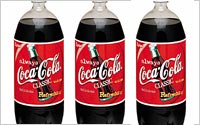
Coca-Cola looks to focus its TV ad spending on so-called DVR-proof events, while buttressing them with 360-degree campaigns.
With
ad-skipping rampant, the company has lost faith in the effectiveness of traditional ads in comedies and dramas, save for the Super Bowl, “American Idol” and other programming that
consumers watch live and talk about the next day around the Coke machine.
“The 30-second spots on television (are) no longer the way to do it,” said CFO Gary Fayard at an industry
event. “You still do 30-second spots, but if you’re like me, most of the television you watch, you record and when you then watch it, you skip over all the ads … (but) you will
watch certain shows live because you want to be able to talk about them tomorrow when you go to work.”
advertisement
advertisement
Still, even as advertising is concentrated in live-oriented events and sports, Coke
is planning a major Olympics initiative this summer -- a traditional spot can no longer stand alone, Fayard said. Links and integrated campaigns will use social and digital media -– as Coke did
with Super Bowl ads this year -- and opportunities for consumers to take some ownership of brands and pass along endorsements is crucial.
“A ‘like’ is not good enough -- you
want a ‘share,’” Fayard said, “because consumers today believe … they own our brands. They are the ones that talk to each other … about which brands live up to
their promise and which ones don’t, so having that integrated campaign across all the different platforms is critically important.”
Coke plans to continue to ramp up its investment
in marketing as it sees positive results and continues with its 2020 vision, hoping to usher in a massive revenue increase by the turn of the next decade. Coke has spent $11 billion globally in
marketing over the past two years, with an additional $6 billion or so coming from its 275 bottling partners.
“Our brand health scores are the healthiest we’ve seen in decades, and
they continue to improve across the board,” Fayard said.
Coke will also sponsor the European championship soccer tournament this summer along with the Olympics.
Speaking more
broadly about Coke’s future, Fayard said projections that 1 billion more people will enter the middle class globally over the next eight years -- with a similar number moving to cities from
rural areas -- should prove a boon for the non-alcoholic beverage industry and, by extension, packaged goods businesses.
“No matter how bad the financial crisis has been,” he said,
“wealth is still being created and will be created over the next eight years.”
Coke has 15 brands generating $1 billion a year or more in revenue.